Projects assessed, priorities set
Organization, 02 July 2021
The 54th meeting of the Programme Advisory Committee for Nuclear Physics took place on 23 June via videoconference. It was chaired by Professor M. Lewitowicz. The Chairman of the PAC presented an overview of the implementation of the recommendations taken at the previous meeting. JINR Vice-Director S. Dmitriev informed the PAC about the Resolution of the 129th session of the Scientific Council (February 2021) and about the decisions of the Committee of Plenipotentiaries (March 2021). The main issues discussed at the meeting are listed below.
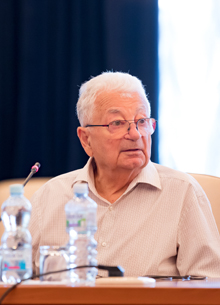 The PAC heard with interest a report by Yu. Oganessian on the synthesis of transuranium elements at FLNR: research and progress in this field, as well as the latest results achieved at the Superheavy Elements Factory (SHE Factory, FLNR JINR) and prospects of further studies at SHE. The report attracted extensive discussion. In the first experiments at SHE Factory on the synthesis of Mc and Fl isotopes in 8Ca + 243Am and 48Ca + 242Pu reactions, respectively, 61 decay events of 288,289Mc isotopes were observed with subsequent decay chains (only 35 chains registered in previous years) and more than 99 decay chains of 286,287Fl (25 chains earlier). High efficiency of the experiments and good background suppression allowed the first-ever recording of 268Db alpha decay leading to the discovery of a new isotope of lawrencium 264Lr.
The PAC heard with interest a report by Yu. Oganessian on the synthesis of transuranium elements at FLNR: research and progress in this field, as well as the latest results achieved at the Superheavy Elements Factory (SHE Factory, FLNR JINR) and prospects of further studies at SHE. The report attracted extensive discussion. In the first experiments at SHE Factory on the synthesis of Mc and Fl isotopes in 8Ca + 243Am and 48Ca + 242Pu reactions, respectively, 61 decay events of 288,289Mc isotopes were observed with subsequent decay chains (only 35 chains registered in previous years) and more than 99 decay chains of 286,287Fl (25 chains earlier). High efficiency of the experiments and good background suppression allowed the first-ever recording of 268Db alpha decay leading to the discovery of a new isotope of lawrencium 264Lr.
The PAC was pleased to note that the launch of the SHE Factory, with the DC-280 cyclotron as the basic facility, modernization of the U-400M cyclotron, and construction of the state-of-the-art experimental facilities considerably extend the range of high-level fundamental and applied research in the fields of nuclear physics at JINR in collaboration with scientific centres of the JINR Member States and other countries oriented at research activities in Dubna. The PAC endorsed the submitted scientific programme on the synthesis and study of SHE properties and wished the FLNR staff success in present and future outstanding experiments.
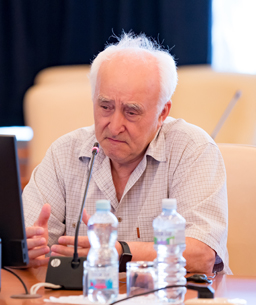 The results achieved in the development of accelerator complex and experimental facilities at FLNR JINR (DRIBs-III) were reviewed by G. Gulbekian. The PAC noted that during the reporting period a wide range of scientific and applied research on heavy-ion physics was carried out at the FLNR cyclotrons DC-280, U-400, U-400М, and IC-100.
The results achieved in the development of accelerator complex and experimental facilities at FLNR JINR (DRIBs-III) were reviewed by G. Gulbekian. The PAC noted that during the reporting period a wide range of scientific and applied research on heavy-ion physics was carried out at the FLNR cyclotrons DC-280, U-400, U-400М, and IC-100.
The commissioning of the experimental complex of the SHE Factory and the launch of the DC-280 basic facility resulted in a number of high-priority experiments. The current task of research at the cyclotron is to increase beam intensities of titanium and chromium ions. The PAC appreciates great emphasis paid to the construction and development of new experimental facilities at FLNR, in particular, the commissioning of a new DGFRS-2 separator as well as development and testing of a system of large-area detectors placed in the focal plane of the separator increasing the efficiency of the reaction product collection by a factor of 1.5, which is of paramount importance for long-running experiments on the SHE synthesis. The FLNR scientific programme also includes construction of the DGFRS-3 pre-separator for radiochemical studies of SHE; an additional magnet is mounted in front of its focal plane to transport the reaction products to a separate facility for subsequent radiochemical analysis. The launch of the DGFRS-3 is scheduled for autumn 2021. The PAC noted that the programme of experimental research at the U-400 accelerator complex in FLNR has been implemented in 2017-2021 according to the plan. The cyclotron beam time was used mainly for research activities on48Ca beams (DGFRS and SHELS setups) and 50Ti (SHELS setup) as well as applied research under contracts with Roscosmos.
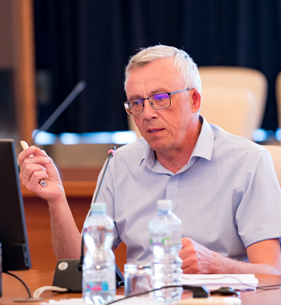 The PAC heard a report by S. Sidorchuk on the programme of the FLNR development for 2022-2023 and proposals on the extension of the themes “Development of the FLNR accelerator complexand experimental setups (DRIBs-III)” and “Synthesis and properties of superheavy elements, structure of nuclei at the limits of nucleon stability”. The activities within this theme include modernization and development of FLNR cyclotron complex, extension of experimental base (construction of new facilities), and upgrade of accelerator systems. The focus is on the stability of the accelerators’ operation, increase in intensity and improvement of quality of ion beams of both stable and radioactive nuclides in the energy range of 5-60 MeV, decrease in energy consumption. The main goal is to considerably increase the efficiency of the experiments on the synthesis and study of SHE properties as well nuclei at the limits of nucleon stability.
The PAC heard a report by S. Sidorchuk on the programme of the FLNR development for 2022-2023 and proposals on the extension of the themes “Development of the FLNR accelerator complexand experimental setups (DRIBs-III)” and “Synthesis and properties of superheavy elements, structure of nuclei at the limits of nucleon stability”. The activities within this theme include modernization and development of FLNR cyclotron complex, extension of experimental base (construction of new facilities), and upgrade of accelerator systems. The focus is on the stability of the accelerators’ operation, increase in intensity and improvement of quality of ion beams of both stable and radioactive nuclides in the energy range of 5-60 MeV, decrease in energy consumption. The main goal is to considerably increase the efficiency of the experiments on the synthesis and study of SHE properties as well nuclei at the limits of nucleon stability.
In the framework of the theme “Synthesis and properties of superheavy elements, structure of nuclei at the limits of nucleon stability”, in 2022-2023 the experiments will continue at the SHE Factory on the synthesis of isotopes of elements 114 (Fl) and 115 (Mc) in reactions of 48Ca with 242Pu and 243Am aimed at detailed investigation of radioactive properties of isotopes from Lr to Mc. A series of experiments is planned to determine the production cross sections of SHE isotopes in the reactions of actinides with 50Ti and 54Cr, which will help define prospects of the synthesis of new elements 119 and 120 and start the first experiments.
Further research of superheavy nuclei will include studies on deep inelastic transfer reactions and quasi-fission as a tool for synthesis of heavy and superheavy neutron-rich nuclei. It will focus on producing neutron-rich heavy nuclei close to the neutron closed shell N=126 as well as new isotopes of transuranium elements in multinucleon transfer reactions of uranium and actinide targets.
At the SHELS and DGFRS-3 separators employing the GABRIELA and SFiNX detection systems, experiments will continue on α-, β-, and γ-spectroscopy of transfermium elements as a source of data on the structures of nuclear levels. First experiments on the spectroscopy of Mc nuclei are scheduled. The PAC recommended extension of the themes for 2022-2023 with the highest priority.
The PAC considered the proposals on the opening and extension of the projects, particular experiments within the themes discussed at the meeting. The PAC members discussed the novelty and relevance of the proposals, and ranked these projects.
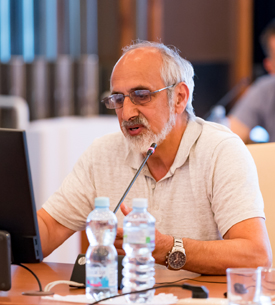 Sh. Zeynalov presented a proposal to open a new project “Investigation of prompt neutron emission in fission (ENGRIN)”. Research of spontaneous fission and nuclear fission at near-barrier excitation energy attracts the scientists as a source of data on the properties of a nuclear system produced just in time of rupture of a neck connecting two fragments. The PAC acknowledged high qualification and broad experience of the ENGRIN project staff in research on fission but recommended the participants evaluating the contribution of neutron scattering at the ionization chamber and neutron detectors.
Sh. Zeynalov presented a proposal to open a new project “Investigation of prompt neutron emission in fission (ENGRIN)”. Research of spontaneous fission and nuclear fission at near-barrier excitation energy attracts the scientists as a source of data on the properties of a nuclear system produced just in time of rupture of a neck connecting two fragments. The PAC acknowledged high qualification and broad experience of the ENGRIN project staff in research on fission but recommended the participants evaluating the contribution of neutron scattering at the ionization chamber and neutron detectors.
The PAC recommended opening the ENGRIN project in 2022 for two years with further extension in case of its successful implementation and funding of the theme. The PAC ranked this project in category B.
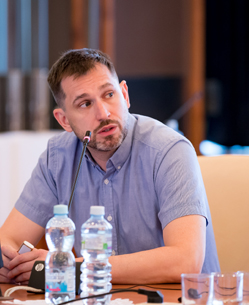 The PAC heard a report by M. Shirchenko on the status of the MONUMENT project aimed at carrying out experimental measurements of muon capture at several daughter candidates for double-beta decay nuclei. The obtained results would have high importance for checking the accuracy of theoretical calculations of nuclear matrix elements. A group of JINR specialists will carry out the measurements at the Meson Factory of Paul Scherrer Institute (PSI), Switzerland. This application was reviewed and approved by the PSI User Committee; the beam time was officially granted for three years. The PAC recognized the potential of the MONUMENT project, recommended its extension for two years, and ranked A priority.
The PAC heard a report by M. Shirchenko on the status of the MONUMENT project aimed at carrying out experimental measurements of muon capture at several daughter candidates for double-beta decay nuclei. The obtained results would have high importance for checking the accuracy of theoretical calculations of nuclear matrix elements. A group of JINR specialists will carry out the measurements at the Meson Factory of Paul Scherrer Institute (PSI), Switzerland. This application was reviewed and approved by the PSI User Committee; the beam time was officially granted for three years. The PAC recognized the potential of the MONUMENT project, recommended its extension for two years, and ranked A priority.
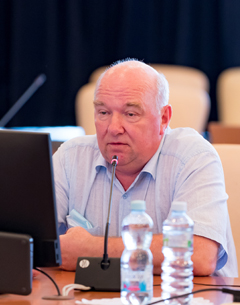 Project “Study of deep subcritical accelerator-driven systems and the possibilities of their application for energy production, transmutation of radioactive waste, and research in the fields of radiation material science (E&T&RM)” presented by A. Baldin is dedicated to the study of reactions in the uranium target exposed to beams of deuterons and protons at the Phasotron. The speaker mentioned two new directions of the project: a new experimental station for the study of nuclear energy technologies, as well as the development and production of a prototype of a beam therapy complex and applied research on heavy-ion beams at the Nuclotron-M facility. The PAC recommended specifying the priorities of the NICA complex project and submitting them at the next meeting of the Committee. The PAC members also recommended continuing the “E&T&RM” project until the end of 2023.
Project “Study of deep subcritical accelerator-driven systems and the possibilities of their application for energy production, transmutation of radioactive waste, and research in the fields of radiation material science (E&T&RM)” presented by A. Baldin is dedicated to the study of reactions in the uranium target exposed to beams of deuterons and protons at the Phasotron. The speaker mentioned two new directions of the project: a new experimental station for the study of nuclear energy technologies, as well as the development and production of a prototype of a beam therapy complex and applied research on heavy-ion beams at the Nuclotron-M facility. The PAC recommended specifying the priorities of the NICA complex project and submitting them at the next meeting of the Committee. The PAC members also recommended continuing the “E&T&RM” project until the end of 2023.
(General information),
Photos by E. Puzynina
